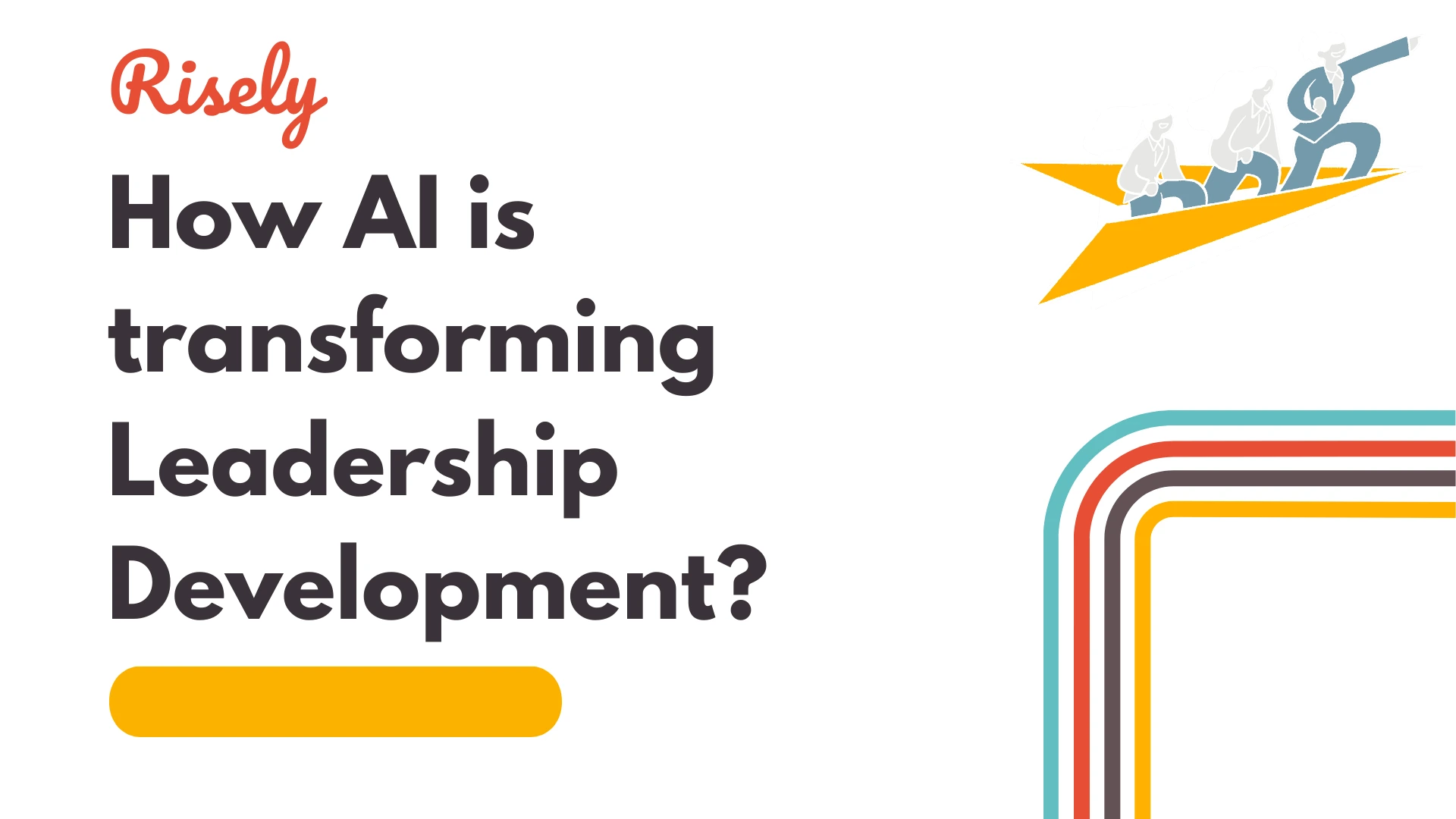How To Curate The Best Learning Environment For Your Team?
Have you ever felt really productive when you are “in the zone”? When you focus intensely, and everything seems easy? That shows how important a good learning environment is. A positive learning environment is not just about a nice place to work. It also means making sure everyone feels they belong. Team members should feel supported and engaged so they can do their best. This article will look at how to build this kind of environment as a part of your learning and development initiatives. We will discuss different learning styles, create a welcoming atmosphere, and share helpful strategies for success.What’s a learning environment and why does it matter?
Let’s return to the starting point:—feeling in the zone, or the flow state, as James Clear would call it. What puts you there? Usually, it is a mix of physical and mental factors; you have a clean and peaceful environment with a mind that has the space and time to deal with the matter at hand. If you are doing it virtually, it could mean a laptop that works smoothly and Zoom calls that don’t make you repeat am-I-audible every other minute. To sum up, your learning environment refers to the physical or virtual setting where learning takes place. It includes multiple aspects:- the physical space you are in
- the mental makeup of your mind
- the social scenario
- the resources and tools available at your disposal
What constitutes the learning environment at work?
| Physical space | Virtual space | Social dynamics | Resources and materials | Psychological factors |
|---|---|---|---|---|
| Classroom layout | Online learning platforms | Interaction between learners | Handouts and digital content | Sense of safety and belonging |
| Lighting and acoustics | Digital tools and resources | Relationship of trainers and learners | Technology and equipment | Motivation and engagement |
| Furniture arrangement | UI and experience of e-learning tools | Collaborative opportunities | Libraries or resource centers | Stress levels and comfort |
What are the common types of workplace learning environments?
A learning environment is a place that helps people learn. It can be a real space, like a classroom, or it can be online. It can also be in casual spots where people gather. There are different types of learning environments that meet different needs and styles of learning. Let’s look at what makes different learning environments unique.#1 Traditional classroom environment
The traditional classroom learning environment at work is a familiar setting for many. It involves face-to-face interactions, structured lessons, and physical materials like books and whiteboards. This type of environment allows for immediate feedback, group discussions, and hands-on activities that cater to various learning styles. However, some drawbacks include limited flexibility in timing and location, as well as potential distractions within a shared space. Despite this, the traditional classroom setting can be effective for your team members who thrive in a structured and interactive learning environment. Plus, it’s great for standard training programs.
#2 On-the-job training
On-the-job training offers a hands-on learning environment where employees learn by performing tasks in real work settings. This type of learning environment allows for practical application of knowledge, immediate feedback from supervisors, and the development of job-specific skills. Unlike traditional classroom settings, on-the-job training is tailored to individual learning styles and job requirements, making it highly effective for skill development and retention. However, you have to face time constraints, limited resources, and search for experienced mentors to guide the learning process.
#3 Virtual learning environment
Virtual learning environments have become increasingly popular, especially after covid, offering flexibility and accessibility for learners. Through online platforms and tools, your team engages in interactive lessons, access resources at their own pace, and collaborate with peers from different locations. This type of learning environment provides the freedom to choose when and where to study, making it convenient for working professionals with busy schedules. Additionally, virtual learning fosters self-discipline, independent thinking, and technological proficiency – skills that are highly valued in the modern workplace.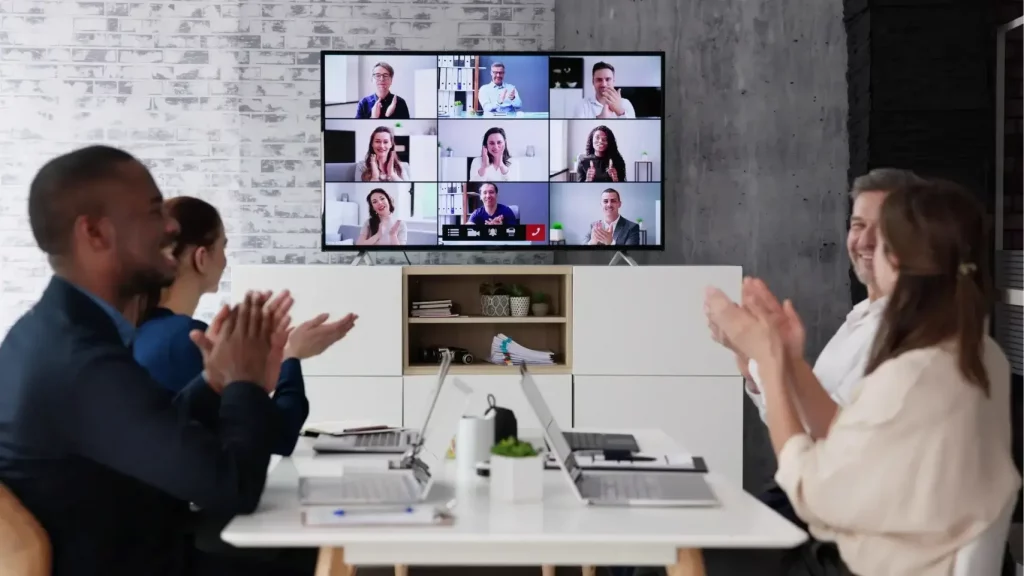
#4 Social learning platforms
Social learning is an innovative way to combine the benefits of structured learning environments with the interactive nature of virtual platforms. Social learning involves in-person interaction that leads to reinforcement and application of learning at work. Online social learning platforms leverage social media tools and online communities to facilitate peer-to-peer learning, knowledge sharing, and collaborative problem-solving. This approach not only enhances employee engagement and motivation but also fosters a sense of belonging and community among team members, regardless of physical proximity, as discovered by LinkedIn.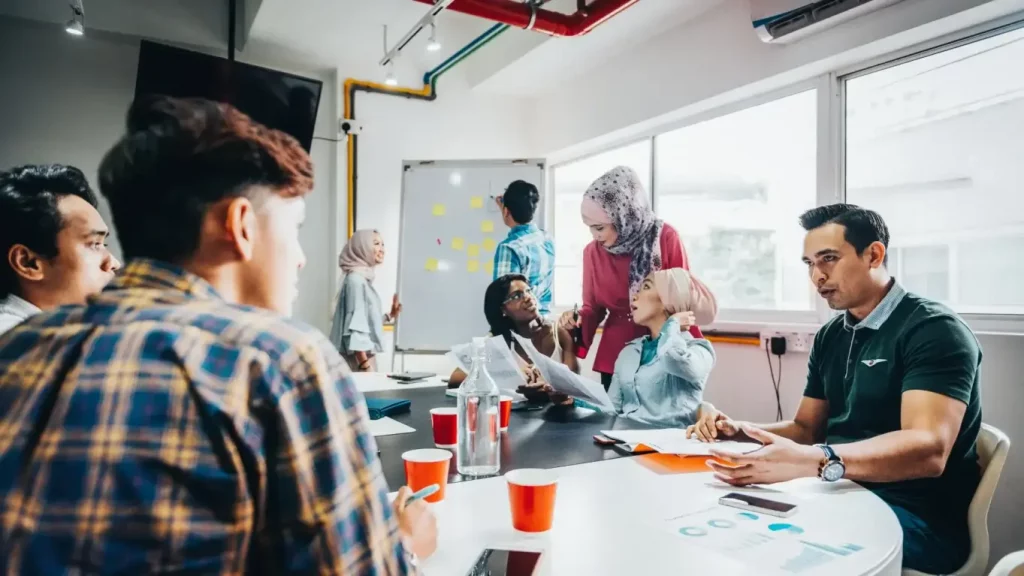
#5 Mentoring and coaching programs
Mentoring and coaching programs play a crucial role in creating a conducive learning environment. Experienced mentors provide guidance, support, and valuable insights to help your team members navigate challenges and enhance their skills. Through one-on-one coaching, mentees receive personalized attention and constructive feedback to aid their professional growth. Coaching programs, on the other hand, focus on unlocking individual potential, setting goals, and developing strategies to achieve them. Coaches serve as accountability partners, motivators, and catalysts for change, empowering learners to unleash their full potential.
Other Interesting Reads
How can you build a great learning environment at your workplace?
Effective learning environments have important traits that help create a good learning experience. Let’s break down each of them to understand how you can build a great learning environment: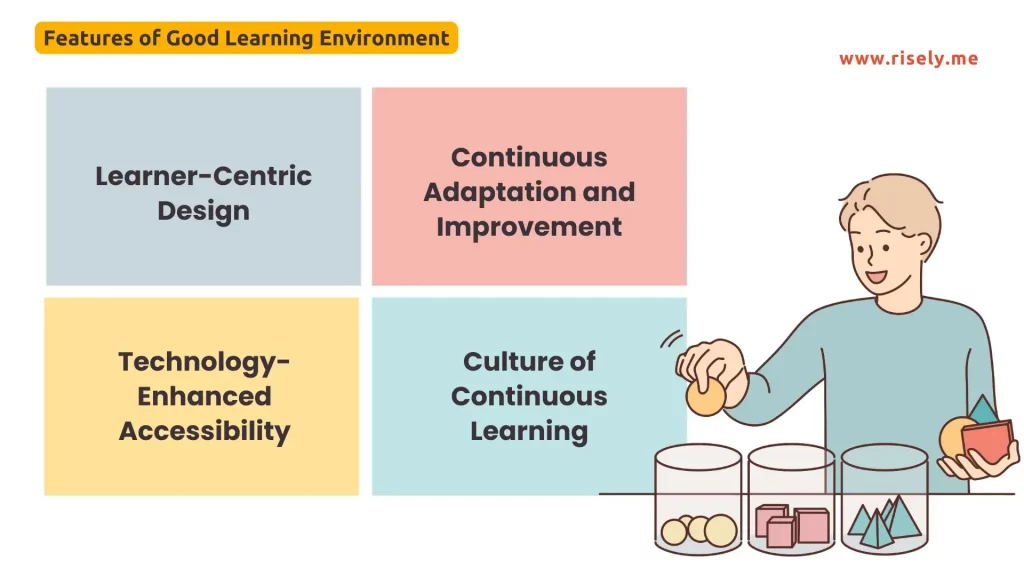
#1 Learner centric design
The first and foremost factor in building a great learning environment is keeping the end-user, i.e. the learner, at the very center of the design process. This principle ultimately comes from the field of product development. Learning designs are a complicated exercise and include multiple facets such as the course content and delivery modules. Environment of the learning at work impacts all of these. You approach should then focus on putting the learner’s needs, preferences, and experiences at the center of all learning initiatives. It involves:- Gathering and acting on learner feedback before and after a training program
- Personalizing learning pathways for different needs and choices
- Offering diverse learning formats to cater to different learning styles
- Ensuring content relevance and immediate applicability to job roles
| Learning Environment Aspect | Without Learner Centricity | With Learner Centricity |
|---|---|---|
| Physical Space | A common classroom with a trainer delivering material | Flexible online/offline space with the option to interact |
| Time and Pace | Fixed schedule (e.g., one 2-hour session) | Self-paced modules |
| Resources and Materials | Static PowerPoint slides for everyone | Diverse media like videos, interactive e-learning modules, simulations with role-specific content |
#2 Continuous adaptation and improvement
The second key tenet to acing learning environment for your team is continuously adapting and improving. This happens due to two set of reasons.Internal reasons
- Organization evolves over time: The first cause of adapting and improving learning is internal. As an organization evolves, the level of maturity in their L&D model changes. At one point an organization might have all learning programs in-house, in their common meeting room, but soon enough when the company grows the learning programs need to change shape and form. They might be reborn as an in-house online content repository that delivers self-paced modules.
- The people evolve: The internal structure of your organization, the people who are influencers and decision makers, as well as the changing needs of participants are a factor in designing a great learning environment. Their feedback and opinions also cause shifts.
External reasons
Learning environments also need to keep up with the changes happening externally, such new methods of learning coming up and new tech that supports novel training methods. For instance, most companies relied on video content up until the last decade heavily, but AI is the newest buzz in town because it can curate personalized content effectively. The environment of workplace learning reflects the broader L&D trends and industry happenings.#3 Technology-enhanced accessibility
Tech is pervasive in the modern times. Thus, if you are skipping on tech in your learning environment, your team could be missing out on a lot of features that define the success of modern learning. Microlearning is just one of those. Other areas of using tech to create a better learning environment could involve:- Leveraging digital platforms for anytime, anywhere learning
- Ensuring user-friendly interfaces and intuitive learning experiences
- Using technology to create immersive and interactive learning content
- Providing multi-device support for seamless learning across devices
#4 Culture of continuous learning
The last, but definitely not the least important part of the equation, is culture. As you must have noted at the start of the article, learning environment also has social and psychological aspects. These two are often harder to navigate than the physical and technical areas, because as an L&D professional you need to approach with empathy for everyone while craving the best way out. The team’s culture is critical to what goes on here. Using culture as a part of learning environment calls for a conscious effort to embed learning into the very core of your organization’s purpose. For example, our team values at Risely call for an approach that focuses on always progressing and being passionate about what we do. It ultimately leads us back to great performance, but before that it is a personal nudge to keep growing in our capacity and area.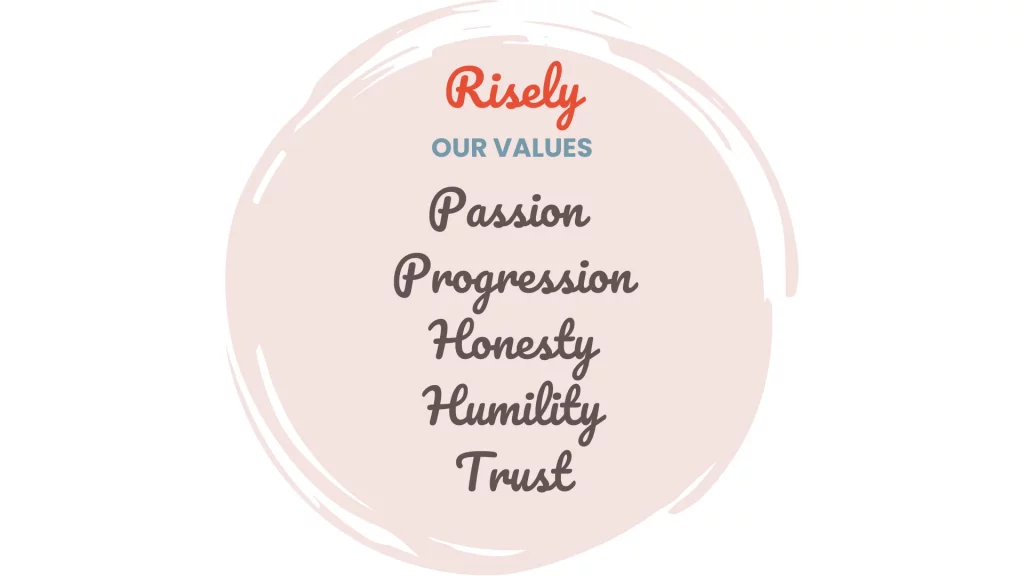
How can you create a culture that adds to a great learning environment?
As the L&D team, your efforts should focus on promoting learning as a core organizational value. This could include recognition of learners in regular meetings, offering opportunities to learn, and even integrating learning KPIs in performance management systems so that the employees are able to see where their personal growth connects with professional success. Second, it’s all about encouraging knowledge sharing and collaborative learning by being deliberate about it. Plenty of teams do not have the ready environment to do this. That’s where you need to step in and double down as the facilitator of change. Your people managers can become learning agents here. The same goes for involving leadership in championing learning initiatives.Hostile learning environments and how to change them?
A hostile learning environment is the opposite of a productive one. It shows up as negativity, disrespect, lack of support, and fear of asking questions. Such places block learning, limit creativity, and slow down team growth – ultimately hurting everything your L&D strategy is trying to achieve. Spotting signs of a hostile atmosphere is the first step to changing it.Signs of a hostile learning environment
- Learners are afraid to ask questions or participate
- Excessive criticism or harsh responses to mistakes
- Exclusion of certain individuals or groups from activities
- Fear of ridicule for making mistakes
- Punishment-based discipline rather than constructive feedback
- Emphasis on individual achievement at the expense of group learning
How can you change a hostile learning environment?
Recognizing these signs is crucial for addressing and improving learning environments. Keeping in mind the key components of a good learning environment that we have seen earlier, you can bring change with your L&D strategy. You should start by focusing on learner-centric design, with which we can create inclusive, respectful environments that cater to diverse needs and foster psychological safety. After than, continuous adaptation allows us to regularly assess and improve the learning climate, addressing issues as they arise. Technology-enhanced accessibility provides tools for anonymous feedback, diverse learning options, and improved communication channels that curb the communication challenges and create an effective feedback loop for the L&D team. Finally, work with stakeholders including the senior leaders and managers on cultivating a culture of continuous learning emphasizes growth, collaboration, and mutual respect, counteracting competitive or intimidating atmospheres. Showcase the ROI that effective learning can bring, and start winning!Wrapping up
Creating a good learning environment for your team is about knowing different types of learning spaces. You also need to overcome challenges and boost engagement using teamwork and technology. It’s important to be flexible, adaptable, and inclusive to create a positive learning culture. Leaders have a big role in supporting different learning styles and improving current settings. By managing resources wisely, addressing resistance, and encouraging open communication, you can create an effective learning environment. This will help your team reach their full potential.Say goodbye to messy learning experiences. Revamp your L&D plans today.
Grab Risely’s free L&D strategy framework and get started on a journey toward growth.
AI and Leadership Development: Driving Synergy for Growth
AI and Leadership Development: Driving Synergy for Growth You know the frustration all too well. Your organization invests thousands in…
How Are AI Learning Platforms Transforming Leadership Development?
How Are AI Learning Platforms Transforming Leadership Development? As an L&D leader, you’re likely familiar with this frustrating reality: 82%…
5 Essential AI Skills for L&D Leaders
5 Essential AI Skills for L&D Leaders According to LinkedIn’s 2025 Workplace Learning Report(1), 71% of L&D professionals are now…
How to Create a Course with AI: A Guide for L&D Professionals
How to Create a Course with AI: A Guide for L&D Professionals According to a McKinsey survey(1), only 11% of…
Building an Ultimate Leadership Development Action Plan
How to Build a Leadership Development Action Plan? Having a strong Leadership Development Action Plan is more critical than ever…


